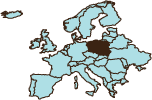Polish Dining Etiquette
Dining etiquette for toasting. The most common toast is na zdrowie (to your health). Another popular toast is stola, meaning one hundred years - implying that you should live to be one hundred years old. Never break eye contact while making a toast, from the moment the glass leaves the table until you place it back down. There can be many different toasts throughout a meal; you will be expected to make a toast in a small group at some point during the meal especially if you have been toasted personally or are the guest of honor.
table manners
Dining etiquette for when to begin eating. Do not begin eating until everyone has received food on their plates and the host invites you to start; this is usually done by saying smacznego.
Dining etiquette for utensils. The knife remains in the right hand, and the fork remains in the left. When the meal is finished, place your fork and knife horizontally across the plate, facing left; this indicates that you are finished.
If you're unsure of which utensil to use, always start from the outside and work your way in, course by course. The fork and spoon above your plate are usually for dessert.
Dining etiquette for eating soup. Occasionally, soup is served without spoons: this means you are expected to lift the soup bowl up to your lips and sip it like a drink (the soup will usually be served in smaller bowls resembling cups, if this is the case).
Dining etiquette for eating bread. Bread is usually served without butter and there usually is no bread plate.
Dining etiquette for placing your hands. Your hands are expected to be visible above the table. Rest your wrists on top of the table.
Dining etiquette for passing food. At the table, pass all dishes to your left.
Dining etiquette for eating gravy or sauce. If there is gravy or sauce, you can generally use your bread to soak some of it up.
Dining etiquette for seating. The most honored position is at the head of the table, with the most important guest seated immediately to the right of the host (women to the right of the host, and men to the right of the hostess). If there is a hosting couple, one will be seated at each side of the table. Men typically rise when women enter the room, and may or may not enter a room first when a woman is present. At the table, the oldest or most honored guest is served first.
Dining etiquette for restaurants. In informal restaurants, you may be required to share a table: if so, do not force conversation; act as if you are seated at a private table. Waitstaff may be summoned by making eye contact.
Dining etiquette for discussing business. The business lunch or dinner, depending upon how well developed your relationship is with your Polish colleagues, is generally not the time to make business decisions. Take your cue from your Polish associates.
Dining etiquette for the home. Allow the more senior members of your party to enter rooms ahead of you. At the table, do not presume to seat yourself, as the seating arrangement is usually predetermined. You might have to remove your shoes before entering a Polish home.
Dining etiquette for paying the bill. Usually the one who does the inviting pays the bill, although the guest is expected to make an effort to pay. Sometimes other circumstances determine the payee (such as rank).
Dining etiquette for tipping. A 10 percent tip is usually sufficient for restaurants. Restaurants usually have the 10 percent tip already included on the bill, but if you are un¬sure, ask if service is included.


-clean.jpg)